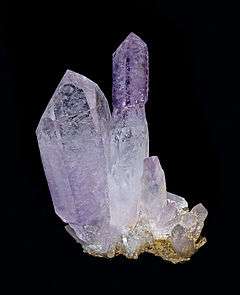
Celestine (mineral)
Celestine or celestite (SrSO4) is a mineral consisting of strontium sulfate. The mineral is named for its occasional delicate blue color. Celestine is the principal source of the element strontium, commonly used in fireworks and in various metal alloys.
Occurrence
Celestine occurs as crystals, and also in compact massive and fibrous forms. It is mostly found in sedimentary rocks, often associated with the minerals gypsum, anhydrite, and halite.
The mineral is found worldwide, usually in small quantities. Pale blue crystal specimens are found in Madagascar.
The skeletons of the protozoan Acantharea are made of celestine, unlike those of other radiolarians which are made of silica.
In carbonate marine sediments, burial dissolution is a recognised mechanism of celestine precipitation.
Geodes
Celestine crystals are found in some geodes. The world's largest known geode, a celestine geode 35 feet (10.7 m) in diameter at its widest point, is located near the village of Put-in-Bay, Ohio, on South Bass Island in Lake Erie. The geode has been converted into a viewing cave, Crystal Cave, with the crystals which once composed the floor of the geode removed. The geode has celestine crystals as wide as 18 inches (46 cm) across, estimated to weigh up to 300 pounds (135 kg) each.

Mineral
A mineral is a naturally occurring substance, representable by a chemical formula, that is usually solid and inorganic, and has a crystal structure. It is different from a rock, which can be an aggregate of minerals or non-minerals and does not have a specific chemical composition. The exact definition of a mineral is under debate, especially with respect to the requirement a valid species be abiogenic, and to a lesser extent with regard to it having an ordered atomic structure. The study of minerals is called mineralogy.
There are over 5,300 known mineral species; over 5,070 of these have been approved by the International Mineralogical Association (IMA). The silicate minerals compose over 90% of the Earth's crust. The diversity and abundance of mineral species is controlled by the Earth's chemistry. Silicon and oxygen constitute approximately 75% of the Earth's crust, which translates directly into the predominance of silicate minerals. Minerals are distinguished by various chemical and physical properties. Differences in chemical composition and crystal structure distinguish various species, and these properties in turn are influenced by the mineral's geological environment of formation. Changes in the temperature, pressure, or bulk composition of a rock mass cause changes in its minerals.
Wine tasting descriptors
The use of wine tasting descriptors allows the taster to qualitatively relate the aromas and flavors that the taster experiences and can be used in assessing the overall quality of wine. Wine writers, like Karen MacNeil author of The Wine Bible, differentiate wine tasters from casual enthusiasts; tasters attempt to give an objective description of the wine's taste (often taking a systematic approach to tasting), casual enthusiasts appreciate wine but pause their examination sooner than tasters. The primary source of a person's ability to taste wine is derived from his or her olfactory senses. A taster's own personal experiences play a significant role in conceptualizing what he or she is tasting and attaching a description to that perception. The individual nature of tasting means that descriptors may be perceived differently among various tasters.
The following is an incomplete list of wine tasting descriptors and a common meaning of the terms. These terms and usage are from Karen MacNeil's 2001 edition of The Wine Bible unless otherwise noted.
Mineral (band)
Mineral was an American emo band originally from Houston, Texas. Soon following their formation they relocated to Austin. All four members of Mineral were signed to Interscope Records on individual contracts. After disbanding in 1998, its members worked on numerous other musical projects including The Gloria Record, Pop Unknown, and Zookeeper.
Mineral's music is characterized by its iterated soft/loud structure, overlaid with melodic vocals and ethereal guitar-based instrumental bridges. Mineral's subtle balance between angst-ridden kinetics and wistful underpinnings, in conjunction with their intelligent lyrics, have heavily influenced many bands of the late 1990s and 2000s.
In 2010, a compilation CD of all the band's songs (except for "Sadder Star", from the First Crush comp) was released in Japan, entitled "The Complete Collection".
Mineral announced a reunion tour on April 24, 2014.
Members
Podcasts:

